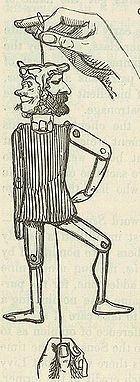
Jumping jack (toy)
Encyclopedia

Puppet
A puppet is an inanimate object or representational figure animated or manipulated by an entertainer, who is called a puppeteer. It is used in puppetry, a play or a presentation that is a very ancient form of theatre....
and a paper doll
Paper doll
Paper dolls are figures cut out of paper, with separate clothes that are usually held onto the dolls by folding tabs. They have been inexpensive children's toys for almost two hundred years. Today, many artists are turning paper dolls into an art form....
. The figures are generally made from wood. Their limbs are jointed and tied to a pull string. When the string is pulled and released, the arms and legs move up and down.
History
Although the jumping-jack is popularly thought of as a European toy, ivory dancer figures made to spin by pulling their strings, which were found at the archaeological site El Lisht and date back to ancient EgyptAncient Egypt
Ancient Egypt was an ancient civilization of Northeastern Africa, concentrated along the lower reaches of the Nile River in what is now the modern country of Egypt. Egyptian civilization coalesced around 3150 BC with the political unification of Upper and Lower Egypt under the first pharaoh...
ian times, are considered to be among the earliest forms of this family of mechanical toys.
In the mid-1700s, jumping-jack figures known as “pantins” were popular among the French nobility.
In 1832 the Hampelmann was created by Carl Malss as a figure for the burlesque at Frankfurt
Frankfurt
Frankfurt am Main , commonly known simply as Frankfurt, is the largest city in the German state of Hesse and the fifth-largest city in Germany, with a 2010 population of 688,249. The urban area had an estimated population of 2,300,000 in 2010...
. Later the jumping-jack toy became known as Hampelmann in German
German language
German is a West Germanic language, related to and classified alongside English and Dutch. With an estimated 90 – 98 million native speakers, German is one of the world's major languages and is the most widely-spoken first language in the European Union....
-speaking countries and were manufactured in the Erzgebirge mountain range in Germany
Germany
Germany , officially the Federal Republic of Germany , is a federal parliamentary republic in Europe. The country consists of 16 states while the capital and largest city is Berlin. Germany covers an area of 357,021 km2 and has a largely temperate seasonal climate...
.
Quocker-wodger
Michael QuinionMichael Quinion
Michael Quinion is a British etymologist and writer. He runs the web site World Wide Words, devoted to linguistics. He graduated from Cambridge University, where he studied physical sciences after which he joined BBC radio as a studio manager.-Writer:...
of World Wide Words has written an article about the word quocker-wodger, defined as "a wooden puppet on a string". (Quinion writes on international English from a British viewpoint.)

